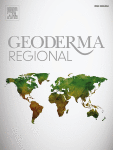Ver ítem
- xmlui.general.dspace_homeCentros Regionales y EEAsCentro Regional La Pampa - San LuisEEA AnguilArtículos científicosxmlui.ArtifactBrowser.ItemViewer.trail
- Inicio
- Centros Regionales y EEAs
- Centro Regional La Pampa - San Luis
- EEA Anguil
- Artículos científicos
- Ver ítem
Land-use change affects soil hydro-physical properties in Mollisols of semiarid Central Argentina
Resumen
The objective of the present study was to describe the relationships between soil physical properties and to identify variables that determine the pore system and hydrological functions which are specifically important in drought prone semiarid marginal croplands. We compared Mollisols under natural vegetation (NV) with their agriculture (AG) pairs in the central Argentinean Dry Pampas to obtain the range of values for variables that characterize the soil
[ver mas...]
The objective of the present study was to describe the relationships between soil physical properties and to identify variables that determine the pore system and hydrological functions which are specifically important in drought prone semiarid marginal croplands. We compared Mollisols under natural vegetation (NV) with their agriculture (AG) pairs in the central Argentinean Dry Pampas to obtain the range of values for variables that characterize the soil pore system. These were total carbon (OC), bulk density (BD), structural instability index (SII), volumetric weight of aggregates (VAW), total porosity (TP), macropores (Ma), saturated hydraulic conductivity (K), infiltration rate (IR), Dexter's S index (S), and least limiting water range (LLWR). To a depth of more than 23 cm, TP and Ma were considerably lower (~ 35% and 50% less, respectively) in AG versus NV. The changes in porosity and pore size resulted in 74% smaller IR and 65% lower K. The S index had mean values of 0.16 and 0.14 for the upper and middle layer respectively in NV; while for AG, these values were significantly lower (0.09 and 0.10, respectively). The LLWR was also lower in AG (21 and 59% less in the upper and middle layer, respectively), due to high soil resistance even at non-limiting BDs (1.17 and 1.32 g cm−3 for AG2 and AG1, respectively). Soil OC was positively correlated with TP, Ma, and S, and negatively correlated with BD and SII. Multiple regression models for S included SII, TP, and clay contents, while for LLWR the variables were OC, TP, and clay plus silt. Thus, these complex soil quality indices can be predicted by using simpler physical parameters, but texture and organic matter also have a strong effect on them. Moreover, our results contribute to a better understanding of the role of texture and organic matter in controlling soil physical quality and for maintaining soil-based ecosystem services.
[Cerrar]

Autor
Fernandez, Romina;
Belmonte, Valeria;
Quiroga, Alberto Raul;
Lobartini, Carlos;
Noellemeyer, Elke;
Fuente
Geoderma Regional 25 : e00394 (junio de 2021)
Fecha
2021-06-01
Editorial
Elsevier
ISSN
2352-0094
Documentos Relacionados
Formato
pdf
Tipo de documento
artículo
Proyectos
(ver más)
INTA/2019-PE-E2-I042-001/2019-PE-E2-I042-001/AR./Uso y gestión eficiente del Agua en Sistemas de Secano
Palabras Claves
Derechos de acceso
Restringido
 Excepto donde se diga explicitamente, este item se publica bajo la siguiente descripción: Creative Commons Attribution-NonCommercial-ShareAlike 2.5 Unported (CC BY-NC-SA 2.5)
Excepto donde se diga explicitamente, este item se publica bajo la siguiente descripción: Creative Commons Attribution-NonCommercial-ShareAlike 2.5 Unported (CC BY-NC-SA 2.5)

